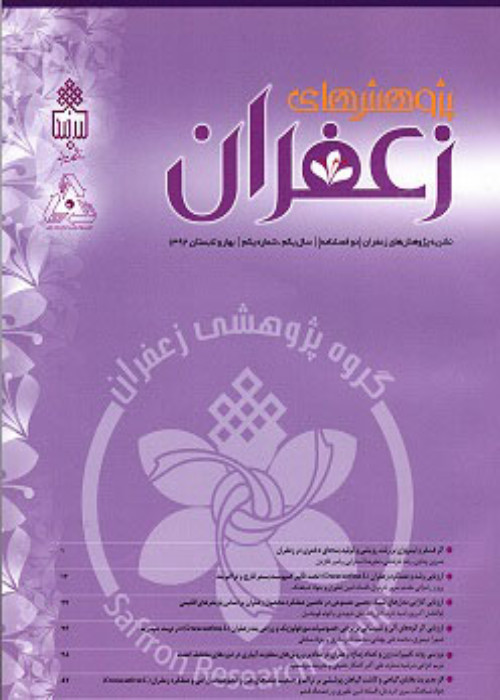The Effect of Potassium Sulfate and Seaweed on Vegetative Growth and Yield of Saffron (Crocus sativus L.)
Saffron (Crocus sativus L.) is one of the most expensive and unique spices in the world and is probably the result of the mutation of the wild plant Crocus cartwrightiamus and belongs to the family of lilies. Today, the issue of organic agriculture is discussed, in which, in addition to the quantity of production, special attention is paid to quality, stability, and sustainability in production. Therefore, organic fertilizers can be a good substitute for these materials in biological agriculture. Seaweed extract is one of the major renewable sources of seas in the world, it contains elements of nitrogen, phosphorus, potassium, and some micronutrients (iron, copper, zinc, cobalt, molybdenum, manganese), growth hormones (auxin and cytokinin), vitamins and amino acids and it stimulates the growth and development and increases the performance of plants. Potassium also plays key roles in many physiological and biochemical processes such as photosynthesis, protein production, sugar production and transport, activation of more than 60 types of enzymes, regulation of osmotic and ionic potential, regulation of opening and closing of stomata, and formation of phloem vessels. To investigate the effect of potassium sulfate and seaweed, an experiment was performed on vegetative growth, yield, and corm saffron.
This experiment was carried out in the 2018 and 2019 years as factorial and the form of a randomized complete block design with three replications in Sarayan City of South Khorasan province. Experimental factors included four levels of potassium sulfate (0, 100, 200, and 300 kg ha-1) and three levels of seaweed (0, 1, and 2 per thousand). Before conducting the test and preparation operations, random soil sampling was done from a depth of 0-30 cm for the soil analysis test (Table 1). Plots were created with a length of two meters and a width of one meter. The distance between the plots was 50 cm, and the distance between the blocks was 1.5 meters, including the streams used to irrigate the plots. On the specified dates, the corms were removed from the mother farm, and after preparation and disinfection with benomyl fungicide with a concentration of two per thousand, they were planted in the field on the same day according to the plan (only corms with weight eight to 10 grams were used for planting). To apply foliar treatment with seaweed fertilizer, after preparing the solutions with desired concentrations, foliar spraying was done using a backpack sprayer and after calibrating it. Simultaneously with the beginning of flowering (late November 2018), the flowers of each plot were collected daily from the entire surface of the plots. Statistical analysis of data was done using SAS 9.4 software. A comparison of average data was also made using a protected LSD test at a five percent probability level.
The results showed a significant effect of the treatments used on the studied traits, The highest number of flowers per square meter, yield of fresh flowers, fresh and dry stigma yield, and mean number of buds with flowering potential in each corm in the second year and the highest leaf length, weight fresh and dry leaves, total number and weight of corms, mean weight of each corm and mean weight of the original girl corms were obtained in both years at 300 kg ha-1 treatment of potassium sulfate. In addition, the results show a significant effect of seaweed (two per thousand) on the number of flowers per square meter, yield of fresh flowers, fresh and dry stigma yield in the second year, and leaf length, fresh and dry leaf weight, total weight of corms, mean weight of each corm and mean weight of the original girl corms in both years. Total weight of corms and weight of coriander more than 12 g in the first year and number of flowers per square meter, yield of fresh flowers, yield of fresh stigmas in the second year, and fresh leaf weight in both years in 300 kg h-1 treatment of potassium sulfate and the concentration of two per thousand seaweed had the highest increase. Also, the highest average weight of each corm in both years was obtained in the treatment of 200 kg ha-1 of potassium sulfate and a concentration of two per thousand seaweeds.
According to the results of this study, the use of potassium sulfate fertilizer (300 kg h-1) and seaweed (two per thousand) alone can play an effective role in increasing vegetative growth, yield, and corm saffron, but their simultaneous use will be more effective.
- حق عضویت دریافتی صرف حمایت از نشریات عضو و نگهداری، تکمیل و توسعه مگیران میشود.
- پرداخت حق اشتراک و دانلود مقالات اجازه بازنشر آن در سایر رسانههای چاپی و دیجیتال را به کاربر نمیدهد.




